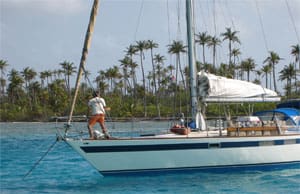Have you ever found the perfect waterfront boaters’ bar? I’m still searching, but I know what it looks and smells like. It’s right on the waterfront — you can dinghy right up to it, hop ashore and stumble back to the dink at the end of the evening. The clincher: when you’re in the mood for mischief, you can bring up a story about your favorite anchor and before you know it there will be a near riot!
Strong men and women have fled from many a boating forum in tears after near-death experiences in anchor threads. Why is this? Like one’s religion, or lack thereof, it is part nurture, part experimentation, part preaching, part experience and part blind faith. Most boaters move back and forth through these stages in their voyaging careers, but many settle in one category or another and will defend their positions vehemently, just like their religions.
Where do you fall on the spectrum? The “nurture” folks are the ones who learned to use anchor X and will never even look at another. They probably have their favorite anchor tattooed on their biceps. The experimenters are the ones who are never quite sure they’ve found their true love. The preachers are the ones who have experimented and now KNOW IT ALL! The experienced ones are likely to carry an array of steel and aluminum that makes their decks look like the beaches of Normandy covered with tank traps. The blind-faithers often have a single enormous anchor perched on the bow shackled to oversized chain and backed up with a windlass that could lift the entire boat.
I fall into the “experimenter” class. I like to try different anchors to see what they offer, but I can never get to the point where I have blind faith in one or another.
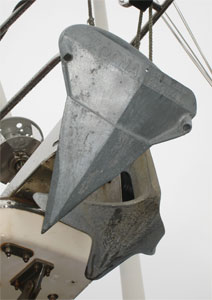 |
|
Multiple primary anchors: many voyagers carry more than one type of anchor as on this boat, which has a Rocna anchor and a Bruce anchor on its bow. |
|
John Kettlewell |
Needless to say, we experimenters believe we have the true wisdom. We believe there is no single best anchor. There are anchors that are great all-around, but there are also anchors that are better in specific situations. Most recent anchor developments have tried to combine the best characteristics of older anchor types, while eliminating weaknesses in order to create anchors that will hold better in most situations. What does that mean?
Hooking-burying anchors
There were two broad categories of anchors identified by Earl Hinz in his classic work: The Complete Book of Anchoring and Mooring: hooking anchors and burying anchors. Hooking anchors were ones like the traditional fisherman anchor that had two sharpish points that could penetrate through hard sand, wedge within a rocky bottom or slice down through thick weeds to the bottom. Burying anchors, like the Danforth pattern or the original CQR hinged plow anchor, were designed for mud or sand bottoms where the anchor could dive down deep until it was often completely beneath the surface.
The hookers rely on snagging something immovable to provide holding power, while the burying anchors try to dive deeper and deeper until they are held in place by the mass of the bottom substrate. Both concepts are valuable in anchoring. I recall trying to retrieve two Fortress anchors from the bottom after Hurricane Bob. As measured by the thick, caked mud on the chain, both anchors had been buried more than six feet into the bottom and took many hours to retrieve. On the other hand, anchoring along the Caribbean coast of Mexico is often more like fishing — you try to snag some tiny protuberance or indentation on the bottom with the sharpest anchor you’ve got. The bottom was often impenetrable sand that had the holding power of an airport runway.
The so-called “new-generation” anchors that are justifiably popular have combined these two basic characteristics to gain the advantages of each. Many new-gen anchors have broad, scoop-shaped holding surfaces to provide tremendous holding power when deeply buried, but the scoop tapers to a very hard and sharp point that provides that initial penetration into the bottom to start the process, and can also grapple for purchase on bottoms that are impenetrable.
You’ll also see hoops on many newer anchors. The hoops are designed to rotate the anchor when it hits a hardish bottom in order to get that sharp point to penetrate and start the entry point into the bottom for the rest of the anchor to follow. Other anchor designs achieve this effect with weight distribution and anchor shape. The hoops do work at their assigned task and can provide a great grip when manhandling the anchor around on deck. However, a hoop is not a magic elixir providing special powers; the holding power of the anchor is provided by other components.
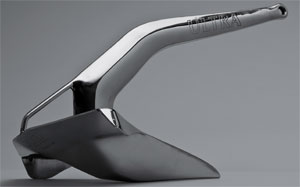 |
|
A stainless steel Ultra anchor, which has a hollow shank to help orient the anchor to dig in. |
|
Courtesy Quickline |
Traditional burying anchors
You will hear many disparaging comments about older anchors in our favorite waterfront bar but keep in mind that, despite what you hear, people like Eric Hiscock and Hal Roth managed to blunder around the world several times relying mostly on what I call the Big Two of anchors: the genuine CQR hinged plow-type anchor, and the genuine Danforth anchor. I know from personal experience with both that, when properly used, they will bury deep into mud bottoms and provide exceptional holding power. My boats have ridden out several hurricanes riding on a combination of Danforth-type anchors and CQRs.
I prefer to use the term “CQR” rather than “plow anchor” because the genuine CQR was the originator of the type. There are many hinged plow knock-offs, but many are poorly constructed, have the wrong dimensions or otherwise don’t work as well as the originals.
Some voyagers malign this great design because in certain bottoms it is hard to get the anchor to penetrate properly, and then it never develops full holding power. However, like all anchor types, some techniques can be used to get the most from the design. For example, it is often best to let the anchor settle for a prolonged period before backing down hard, particularly if the bottom is either very soft or very hard. This lets the anchor slowly penetrate softer bottoms in order to reach better holding material, and/or it lets the point of the anchor gradually work its way into the substrate.
A later development of the plow type was the Delta design, utilizing a fixed (no hinge) and much thinner shank, and a much broader fluke area. The shank has a lot of arch in order to flip the anchor upright on the bottom to encourage the sharper point to start digging in. You’ll notice that many newer designs have copied this arched shank. An advantage of this anchor pattern is its much lower cost, compared to the genuine CQR, so you will see a lot of these and their knock-offs coming as standard equipment on all sizes of yachts, often in sparkling stainless steel. By all accounts, the Delta type is an improvement over the original CQR in all aspects except for brute strength — and apparently the design is easy to copy, as many seem happy with variations on the theme created by numerous companies. For example, Australian company Anchor Right makes the SARCA Excel that looks similar and has garnered some good press.
Danforth anchors were famously used to help pull landing craft off the beaches in WWII, and they inspired the modern Fortress aluminum anchor design. Both types still provide the highest numbers in terms of holding power per pound of weight when well buried. The original Danforth is one of the most scientifically designed and tested anchors of all time. Anchor aficionados should locate and purchase old copies of Danforth documentation and brochures, like “Anchors and Anchoring.” These publications are full of interesting and useful testing and anchor-use information. As is often the case, beware of cheap imitations that manage to both corrupt many aspects of the design and use lousy materials. I have owned some crummy versions that were nearly useless in all but the lightest breezes.
The Bruce anchor became the hot topic in many a waterfront bar in the ’70s. The company originally produced (and still does) enormous anchors used to anchor offshore oil rigs, so it seemed to make sense that the thing could secure puny pleasure boats. The Bruce was strong, had decent fluke area and tended to be forgiving in use, according to its proponents. However, even its strongest supporters said that one had to go up a size or two to get sufficient holding power, and world voyagers sometimes carried anchors twice the normal size. Apparently there is some scale effect with Bruce anchors that requires a fair bit of weight before you gain all the advantages.
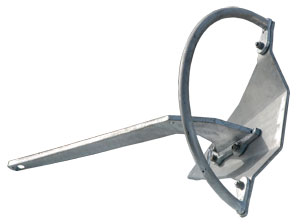 |
|
A Mantus anchor has a hoop designed to ensure proper anchor orientation, and a heavy tip to aid in digging in. |
The genuine original Bruce is no longer made, but there are many knock-offs available, often called “claw” anchors. Watch out for some of these — I have seen several bent and broken claw-type anchors. Some are made of cast steel and tend to shatter when strained. The main advantage of this design seems to be easy setting, reliable holding in moderate winds and has an ability to hook into rocky and weedy bottoms.
Fortress aluminum anchors represent further development of the tried-and-true Danforth anchor pattern. The Fortress improves on the original design by providing sharper blades (watch your shins when carrying one of these!) that provide that hooking and slicing action, which is frequently needed to initiate the critical burying stage. That’s the new-generation advantage I mentioned above: burying plus hooking to get the best of both worlds.
The Fortress design is unique in that it includes the ability to switch between a standard fluke angle of 32 degrees for use in clay, mud or sand, and a 45-degree angle for use in very soft mud. Recent rigorous tests in Chesapeake Bay proved the advantages of the steeper angle in soft bottoms (see “A True Number Two Anchor,” issue #223). In terms of maximum holding power in a straight-line pull in mud or sand (the majority of anchoring situations) the Fortress design is always near or at the top of the heap due to its large fluke area and precision angles.
Here’s the scoop
When you hear the term “new-generation anchor,” someone is probably referring to one of many designs that incorporate several principles: a very sharp point; a broad, scoop-shaped fluke area roughly in the shape of a backwards plow; a thinnish shank, and no pivoting or hinged parts. Many add a big hoop on the back (Rocna, Manson Supreme, Mantus, etc.) that is designed to roll the anchor into the digging position when it lands on the bottom, while others utilize the very arched shank and extreme toe weight along with a sharp point to start the penetrating action (the Spade, West Marine Scoop, Ultra Anchor, Manson Boss, Rocna Vulcan, etc.). The Ultra has a sort of mini roll bar, called a non-foul chain bar, which I suspect aids in rolling the anchor upright and also provides a handle when you are struggling to move the anchor off or onto the roller.
Most report great results with these newer anchors, and they do seem to be easier to use. The sharp points, roll bars, weight distribution and shank designs promote the anchors rolling upright and penetrating the bottom quickly, and then the large scoops provide plenty of holding power. I’ve used a Mantus anchor and it has all of these characteristics, plus an additional unique one: It can be dismantled. That sounds trivial, but in practice it means that a spare anchor, or possibly an enormous storm anchor, can be disassembled and stored down below. It also makes shipping and mounting on the boat easier as the parts are lighter to carry.
Some have reported that the scoop-shaped anchors tend to clog up with balls of thick weed or mud at times, and I have observed this when anchored in places like Cuttyhunk Pond. The scoops can bring up a lot of mud and grass. Others wonder if the thick roll bars limit anchor penetration in certain bottoms. That may be the case, though if these anchors are buried as far as the roll bar, you will already have tremendous holding power. The scoop types tend to have much more surface area than older anchors and buried surface area is what provides ultimate holding power. One possible challenge with roll bars is that they won’t work with some bow roller arrangements.
Odd man out
We experimenters are always interested in trying something new, and anchor inventors don’t disappoint. There are many specialized designs that don’t fit neatly into a particular category. The Super SARCA from Australia is a sort-of plow, yet not a scoop, but with a much shallower blade angle, a big roll bar on the back, a thin shank and all sorts of nifty special features. Rocna, one of the early and popular roll-bar anchors, is now joined by the Vulcan, which appears to be a further development of the spade-type anchor. The main impetus seems to be a search for an anchor without the hoop on the back. The Hans Stealth anchor has a unique double-sided design so it can’t fall on the bottom “upside down,” and its shape is reminiscent of a stealth fighter-bomber. The Super Max anchor seems to have one of the largest scoops around, which would indicate good holding in deep mud. It also features an adjustable shank for different conditions. The Knox anchor is another scoop with a hoop with a difference anchor. The designer has done a lot of interesting anchor testing and his website is worth a read.
And then there are the real traditionalists who want an anchor that looks like an anchor. The three-piece Luke Storm Anchor has the traditional Herreshoff fisherman anchor shape that makes for a great tattoo, and it can be dismantled for storage. Its hooking action can be excellent in rocks and thick weed.
Choices, choices
With all of these different anchors on the market, how does one decide what is best? The first place to start is to see what might fit on your bow roller. Many boats can’t accommodate a hoop design, for example, as it blocks the full retrieval of the anchor. In general, I would recommend looking at the new generation anchors as your first choice for your main hook. The best features of the past have been combined with some great new ideas to provide anchors that are easier to use, can provide greater holding power, and tend to be forgiving. However, if your budget is tight and you’ve inherited an arsenal of CQRs, Danforths and Bruces, they can take you around the world just like they have for many voyagers before you.
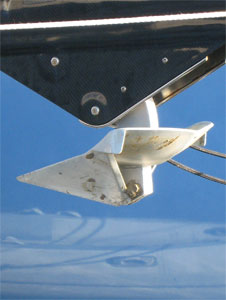 |
|
A Spade Anchor snugged up tight on a bow roller. |
Most cruisers have a main bow anchor they use 90 percent of the time by itself. Therefore it must be a type that can deal with dramatic wind shifts without dislodging. Most of the mainstream new generation anchors fit this bill well. However, it is also important to have some secondary anchors for various purposes. For example, when aground you’ll need an anchor that you can take out in the dinghy, which then will provide enormous holding power as you winch the boat off. A Fortress or Danforth anchor is ideal for that purpose and can make a good second anchor when utilizing a two-anchor set. It is also important to have a backup anchor in case you lose the main one, and to use as needed when caught in the ultimate storm. Some like to carry a huge storm anchor dismantled down below.
Anchor size
In most cases, the old rule of thumb still holds true when choosing the main anchor size for a cruising boat. Go for one pound of weight per foot of overall boat length, and then choose the next size up. For example, I choose 45-pound anchors for my 38-foot motorsailor. The manufacturers all publish detailed selection charts, but you will find that most end up providing advice very close to this simple rule for world cruisers. You’ll also notice that most published voyaging accounts dispense similar advice. I would be very wary of any anchor company that provided recommendations at odds with this rule. Aluminum anchors are obviously the exception since, once buried, they provide greater holding power than their weight would indicate. However, sheer weight does matter when penetrating thick weed or dense clay or mud, so for two anchors of similar size and shape the heavier one will usually provide better service. That doesn’t mean that aluminum doesn’t have its place, but some feel it is not ideal for the main anchor.
How about stainless steel? It looks good, mud slides off it easier and it makes your wallet lighter. Otherwise there is probably no advantage, and some stainless anchors are significantly weaker structurally than their galvanized steel mates. Anchors like the Ultra are designed from the get-go to be made in stainless and should have plenty of strength.
Some of us need to anchor in places with rocky bottoms, thick kelp or chunks of old coral. Near Tulum in Mexico, I had to anchor where the bottom was so hard nothing could penetrate, and we relied on hooking action and sheer weight to hold us off the beach. A big fisherman anchor like the Luke would have been great to have in that situation. I know some people carry large grappling hooks for places in the Pacific Northwest where you row it ashore and then wrap your anchor line around some trees while another anchor holds you off the rocks. I have anchored in tight spots in the Bahamas where I walked the anchor over a sandbar in order to place it precisely to keep my boat in a narrow strip of deep water.
The bottom line is to choose one or more that are well tested and well built. Stick to a name brand to avoid poor design and construction. Just because an anchor looks like the one on your neighbor’s world-voyager doesn’t mean it will perform the same. And, as always, it is not what you got, but how you use it.
John J. Kettlewell is the author of The IntraCoastal Waterway Chartbook: Norfolk to Miami.

